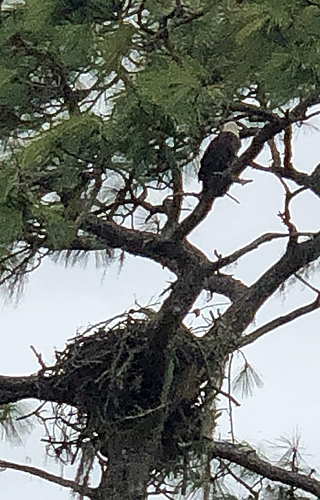Once an eaglet fledges and leaves the nest area for good, it starts its journey in the wild as a juvenile. Recent studies by the US Fish and Wildlife Service show that survival rates for the first year has increased to 70 percent (up from less than 50 percent in earlier studies) as it learns to become independent, find its own food, and face dangers never seen in the nest. If the juvenile makes it through the first year, mortality rates drop significantly each year thereafter.
 Eagles under human care can live for 30 to 50 years, but in the wild, the typical lifespan is 15 to 20 years, although one banded eagle did survive for 38 years in the wild. An eaglet faces some of the earliest mortality dangers in the nest, including congenital deformities, predation, starvation, failure to thrive and siblicide. Congenital deformities may mean that the eaglet does not have the ability to hunt properly, which can lead to early death. There have also been instances of predators taking and harming or killing an eaglet from the nest such as raccoons, Great Horned Owls, or other large raptors. Failure to thrive happens when there isn’t a good food source, often affecting the youngest in a clutch, or even the older sibling killing the younger through aggression and competitiveness over food. It has often been stated that the reason Bald Eagles lay multiple eggs in a clutch is to ensure that at least one eaglet survives to carry forward the species.
Eagles under human care can live for 30 to 50 years, but in the wild, the typical lifespan is 15 to 20 years, although one banded eagle did survive for 38 years in the wild. An eaglet faces some of the earliest mortality dangers in the nest, including congenital deformities, predation, starvation, failure to thrive and siblicide. Congenital deformities may mean that the eaglet does not have the ability to hunt properly, which can lead to early death. There have also been instances of predators taking and harming or killing an eaglet from the nest such as raccoons, Great Horned Owls, or other large raptors. Failure to thrive happens when there isn’t a good food source, often affecting the youngest in a clutch, or even the older sibling killing the younger through aggression and competitiveness over food. It has often been stated that the reason Bald Eagles lay multiple eggs in a clutch is to ensure that at least one eaglet survives to carry forward the species.
Factors We Can Affect
Lead poisoning is a common cause of injury and death of Bald Eagles. A recent study conducted over many years involving thousands of eagles found that almost 50 percent had chronic lead poisoning, and up to 33 percent had acute lead poisoning. Visit https://www.science.org/doi/10.1126/science.abj3068 for study details. Lead is a neurotoxin that, even in levels of exposure as small as a grain of rice, impairs an eagle’s ability to fly, hunt and reproduce, leading to increased disease, accidents and starvation.
According to the Raptor Center, University of Minnesota, “Lead, a naturally occurring element with no functional role in a plant or animal’s system, is extremely toxic to birds. The Raptor Center’s medical clinic admits over 150 injured and ill Bald Eagles each year with 85-90 percent showing some level of lead in their blood. On average, 25-30 percent of these eagles are documented to have lead toxicity. Most of these majestic birds die or are humanely euthanized to alleviate their extreme suffering.”
According to the Wildlife Center of Virginia, “Eagles and other avian scavengers are getting the lead primarily by scavenging the carcasses or remains of animals left in the field by hunters. When shot with lead ammunition, game animals can contain very small pieces of lead, which fragment upon impact with the target…. The threat of lead poisoning of eagles and other birds of prey can be almost entirely eliminated if hunters will voluntarily switch to non-lead ammunition for hunting, thus eliminating the primary source of lead affecting eagles and other scavengers.”
Visit the Wildlife Center of Virginia at https://www.wildlifecenter.org/resources-hunters for alternatives to lead ammunition that hunters prefer.
Rodenticides (poisons used to kill rodents) are another significant source of poisoning. These poisons are slow acting and can take hours or even days to kill a rodent, allowing them to return to the wild carrying the poison in their bodies. Any bird or animal that consumes these rodents (alive or dead) suffers from secondary poison that is potentially deadly. Visit the Raptors Are the Solution website at https://www.raptorsarethesolution.org/ for practical alternatives to rodenticides.
Factors We Can’t Always Affect
There are also dangers that are not as easily affect by our actions. Eagles can face electrocution going into power lines or damage from wind turbines and even strikes with airplanes. Parasites are another danger to eagles in the wild and can lead to death as well as sickness.
Eagles face many diseases in the wild, a few of the more well-known ones being West Nile Virus, Highly Pathogenic Avian Flu and pox viruses, the latter causing blindness and potential beak and talon deformities. Accidents that happen on, or to the side of, roadways are another mortality cause, especially in younger eagles who live on carrion until they learn to hunt at about age three.
Eagles are also injured or killed in territorial fights, especially as the numbers of Bald Eagles has rebounded, and there is more density in nest areas with eagles migrating through, looking for nesting sites, and attempting to find mates.
Some of the more common enemies of Bald Eagles include humans, Great Horned Owls, other eagles and raptors, and raccoons and crows for Bald Eagle young and eggs.
References:
Leslie Brown and Dean Amadon, Eagles, Hawks & Falcons of the World
U.S. Fish & Wildlife Service
Science
The Raptor Center, University of Minnesota
The Wildlife Center of Virginia
Raptors Are the Solution

